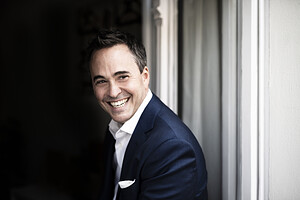Florian Arnold, Braunschweiger Zeitung, March 17, 2024
Cultural appropriation? Classical US culture in Braunschweig
Brunswick. The Staatsorchester's seventh symphony concert features discoveries from the new world in which old Europe sings along.
If you like, the program of the State Orchestra's seventh symphony concert is all about cultural appropriation. Huh, a term like a minefield, but reflecting on forms of expression from other cultures does not necessarily have to be problematic if it is done in an appreciative manner and at eye level. As is usually the case when US composers engage with the classical music of old Europe.
An exciting contemporary example is the piano concerto "Watermark" by 41-year-old composer, violinist and singer Caroline Shaw. In it, Shaw reflects on Beethoven's third piano concerto, which developed the genre from virtuosity to a symphonic dialog between soloist and orchestra and is regarded as an anticipation of his fifth "Fate Symphony". Beethoven wrote both works in his favorite key for dramatic cases, C minor.
Pianist Annika Treutler captivates with Caroline Shaw's "Watermark"
Shaw develops her work "Wasserzeichen", which was premiered in 2018, as if from a primordial cell from the fundamental C initially hummed in unison by the orchestral musicians. Soloist Annika Treutler dabbed high, crystalline chords into the Staatstheater's main hall on Sunday, like drops in a dark, shimmering surface. The mood seems meditative until the piano strikes a single note again and again in a clockwork-like driving manner, thus taking up something of Beethoven's propulsive gesture, albeit more monotonous, straightforward and sequenced in keeping with our times.
In contrast to the classical method of linear exposition, penetration and development of themes, Shaw's approach seems more two-dimensional, more interested in vertical experimentation with sounds and structures. Occasionally, striking Beethovenian motifs shine through her sonic fabric like watermarks, only to be broken down into smaller, quasi-molecular patterns that wander repetitively through the vocal groups.
Mystical and humorous: Charles Ives' "The Unanswered Question"
The introverted second movement is reminiscent of minimal music, before another concise Beethoven quote introduces the dynamic third movement. Soloist Annika Treutler shines here with some rapid runs and the orchestra opens up large sound spaces before everything comes back to the nucleus of the fundamental C at the end. Much applause for an exciting, concentrated ensemble performance and, as an encore, the piano version of Kurt Weill's Caribbean-inspired instrumental piece "Youkali".
Shaw's "Watermark" is as experimental but uninhibited and inspired as Charles Ives' seven-minute piece "The Unanswered Question", a good hundred years older, is mystical and humorous at the same time. A solo trumpet poses dissonant, rubbing, existential "questions" characterized by wide intervallic leaps into an ethereal, harmonious string weave. A woodwind quartet responds in a committed cacophonous manner, like a quarrelling panel of experts. This is repeated several times, varied over the unimpressed cosmic consonance of the strings, in which all the questions are probably suspended.
Florence Price's lively "Dances in the reeds"
The upbeat American program is introduced by an orchestral version of "Dances in the Canebrakes" by Florence Price (1887-1953). Price was the first composer of color whose pieces were performed by renowned US orchestras. The musically highly talented daughter of a dentist (who was officially only allowed to treat black people) and a music teacher had to work hard for her successes and cope with a number of private strokes of fate. Nevertheless, the orchestral version of "Tänze im Röhricht", composed shortly before her death, radiates an airy, ragtime-syncopated lightness.
In contrast, the second symphony (!) by Kurt Weill (1900-1950), who later became an American by choice, is fiercer, more breathless, at times shriller, but no less rhythmically rousing. Composed in Paris in 1933/34 during his flight from the National Socialists into exile in the USA, it sounds like a turbulent melange of Weill's fears, anger, but also a spirit of optimism and desire for the musical forms of expression of the new world. This too is a case of cultural appropriation. Who would blame Weill? Certainly not the New York conductor and Berlin resident Garrett Keast, who conducted this exploratory concert program with great verve and precision.
Translated from the German with DeepL.com (free version)
 Back to List
Back to List